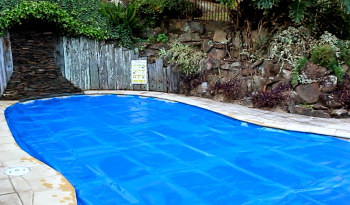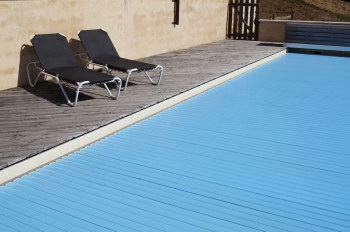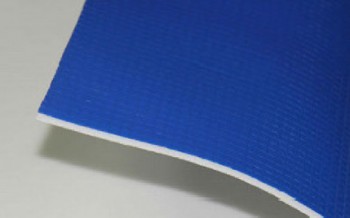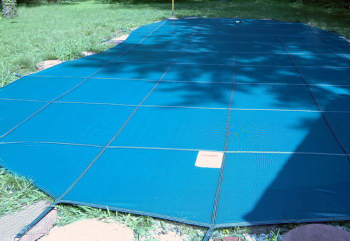Types of Pool Covers
When summer is here, it means it’s pool time! You’re ready for some fun in the sun. The only problem is, your water could be warmer and leaves and other debris have drifted into the pool since the last time you cleaned it. And your chemical and water costs could be less.
There’s a great way to warm your water, cut down on maintenance time and cut your costs, and that’s installing a pool cover.
Solar, thermal, automated, winter, hidden pool covers.
So what kind of cover should you get?
First, consider what a pool blanket can do for you. Pool covers share several things in common. They all:
- Some but not all heat your pool’s water – more on that below
- Reduce evaporation of your pool’s water
- Keep out dirt, debris and leaves that interfere with the pumps and sanitary conditions of the water
- Cut your cleaning time in half
- Dramatically decrease your monthly bills by saving money on heating, water and chemicals needed to maintain your pool
- Keep unwanted animals out of pool such as ducks and iguanas
With so many options, how do you choose?
The different kinds of swimming pool covers each have their unique qualities. The key is learning what each one does in order to decide which one to buy. Below, we compare five of the different types to help you make this decision.
SOLAR POOL COVERS

They are made of a light durable material, and consist of air bubbles, not unlike bubble wrap. Light passes easily through these transparent bubbles to help facilitate heating in the same way that a magnifying glass works. Depending on the size of the pool, the price for a solar pool cover ranges from $40 (kiddie pool size) to $1,400.
Installation is easy and can be done with a pair of household scissors. The bubbles go face down on the water and then is cut to fit the shape of the pool.
Click here to purchase a swimming pool cover and roller.
PROS:
- This is the only swimming pool cover that can increase the water temperature. It will raise the temperature of the water by up to 8 degrees by converting the pool into a solar heater and thereby extending your swimming season by weeks.
- Reduces evaporation by up to 99%, cutting down water costs. They also help keep in the chemicals necessary to keep a pool healthy and sanitary. This decreases the costs incurred from replenishing chemical supplies.
- Keeps dirt and debris out of the pool’s water, limiting how much chemicals are needed to sanitize the water, further keeping costs down.
- Lightweight and easy to use. This makes taking the cover on and off fast and easy.
CONS:
- Difficult to roll take on and off unless you have a cover roller. Most people wouldn’t consider buying a solar cover without a roller though.
- Solar covers cannot withstand the weight of even a small child or animal. They require additional safety precautions like a fence or a gate that latches every time it is opened and closed.
- Don’t insulate the water as well as thermal covers.
AUTOMATIC POOL COVERS

They do come with a hefty price tag but the benefits far outweigh the costs. Many people say the extra money is worth the piece of mind, not to mention, it’s pretty cool to be able to push a button and have it open and close on command.
Auto covers are made of interlocking slats that rest on the surface of the water, and can support the full weight of an adult. A reel operates the slats, automatically covering and uncovering the pool at the push of a button. It can also be locked to prevent young hands from inadvertently opening and closing the cover.
The covers are custom-fit to the measurements of the pool. There are two methods for installation. The first method anchors the pool cover to the ground using snap-down anchors. The second is installing a track. The two tracks need to run parallel to each other to ensure the auto cover can slide through unimpeded.
Automatic pool covers require a professional to install. When installed properly, it is impossible for anyone to fall into the water.
As mentioned above, they are pricey, and start at about $2500 and go much higher.
PROS:
- SAFE! When installed correctly, it is impossible for anyone, especially unsupervised children, to fall into the water.
- Cuts down on evaporation of pool water, saving money on water costs.
- Easy to take on and off.
CONS:
- Pricey, in the $2500-$8000 range.
- Very visible. If you have anything other than a rectangular pool, the track for the cover has to sit above ground, along with the lid for the box. Depending on your needs, the high visibility of the cover’s mechanisms could be unattractive. It is also a trip hazard.
- Doesn’t heat the pool’s water.
THERMAL POOL COVERS

Thermal blankets are made of an insulating foam material, and though they cost a bit more than bubble covers, roughly $900-$3000 range, they do insulate better than solar covers.
Installation is normally done by a professional. The cover can fit just about any pool shape too.
PROS:
- Reduces evaporation up to 98%, insulating the water, thereby extending the swimming season.
- Keeps out leaves, dirt and debris, saving money on chemical cleaning supplies.
- Completely blocks the sun’s UV rays that cultivate destructive algae.
- Easy to use and put away. Thermal covers can be accessorized with a roll-up station and wind protection devices.
- Lasts longer than solar pool covers.
- Can be left out in the sun without danger of damaging the cover.
CONS:
- More expensive than solar pool covers
- Don’t heat the pool water like some other covers do
WINTER POOL COVERS

Made from a polyethylene fabric, these covers keep out winter winds, precipitation and extreme temperatures that can cause frost damage. They are relatively inexpensive, ranging in price from $150 – $700 and prevent a nasty cleanup in the spring by keeping out dirt, leaves and other debris.
Installation is relatively easy. The covers are sewn at the factory and come in their final shape and size. They are designed to overlap the sides of the pool to aid in keeping out dirt and debris, and is further sealed at a fixed point approximately every 800mm.
Anchor points around the pool must be installed for the cover.
PROS:
- Reduces evaporation
- Reduces effective sunlight, thereby limiting the growth of algae, which leads to expensive cleaning and maintenance.
- Lightweight and easy to roll out and roll up.
- Keeps out debris
CONS:
- Does not heat water, retain heat or reduce as much evaporation as other blankets.
- Requires anchor points to be installed around the perimeter of the pool.
- Can’t be easily taken on and off – not good for everyday use.
Hidden Swimming Pool Covers
If aesthetics are important, hidden pool covers are a great option. They have the added bonus of being able to be installed on new or existing pools, and those under renovation.
The blanket and roller housed in a sunken in section at the end of the pool. A lid, which is normally made from anodized aluminum then hides the roller and cover.
When you want to use the cover, you simply open the lid and unroll the cover.
Hideaway covers come manual, automatic or semi-automatic, which makes them very easy to use while at the same time fulfilling all the savings and protection you’d expect from a swimming pool cover.
PROS:
- Good for most pool shapes
- Rolls directly on the water automatically or semi-automatically, or manually by use of an easy-to-use hand crank.
- Ascetically pleasing. When it’s put away, it’s not noticeable like other covers are.
CONS:
- Can be expensive- especially the automatic ones.
- Can be difficult to install in existing swimming pools.
Summary – Types of Swimming Pool Covers
| Feature |
Solar Pool Cover |
Automatic Pool Covers |
Thermal Pool Covers |
Winter Pool Covers |
Hidden Pool Covers |
| Heats Pool Water |
Best |
No |
No |
No |
No |
| Extends Swimming Season |
Best |
Moderate |
Moderate |
No |
Moderate |
| Keeps Out Debris |
Yes |
Yes |
Yes |
Yes |
Yes |
| Ability to Reduce Evaporation |
Yes |
Yes |
Yes |
Least |
Yes |
| Cut’s chemical costs |
Yes |
Yes |
Yes |
No |
Yes |
| Automatic |
No |
Yes |
No |
No |
Can be either |
| Can Walk On |
No |
Can Be |
No |
No |
No |
| Cost |
$600-$1500 |
$2500-$8000 |
$900-$3000 |
$150 – $700 |
$1300+ |
| Value for Money |
1st |
5th |
2nd |
4th |
3rd |
Deciding which pool cover to get can be one of the most important decisions you make when it comes to the extra enjoyment and money savings you will get from your pool. For most people a solar swimming pool cover offers great benefits and they are great value.
Our advice is to consider all the options so you can make the best choice for your situation.
Related Reading:
3 Things You Should Know About Automatic Pool Covers
How to get the Pool Cover Rebate? Are you eligible?
7 Reasons Not to Get a Pool Cover


